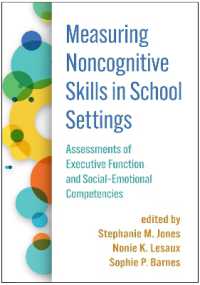- ホーム
- > 洋書
- > 英文書
- > Psychology
Full Description
How can a particular way of argumenting direct our thinking? How does the formulation of a question influence the answer, producing a bias or an insight? And finally, what effect does public communication have on public behaviour?
Psychorhetoric and the Psychology of Thought illustrates the role played by rhetoric and communicative heuristics in the psychology of thinking and decision-making, and its effect on many areas of our daily life. It gives voice to a new and unconventional approach to the contemporary debate within the psychology of thought that has wide implications for key behavioural phenomena, including biases, creativity, decision making and public policy. This innovative work challenges conventional wisdom by proposing that cognitive biases are not inherent flaws in human cognition but rather outcomes of misleading communication patterns that influence our thinking processes.
This unconventional approach to the psychology of thought has significant implications for creativity, decision-making, economic behaviour, and public policy development. Essential reading for students and researchers in cognitive psychology, communication studies, and behavioural economics, this volume promises to reshape our understanding of human rationality and the communicative forces that guide it.
Contents
Acknowledgement. Chapter 1. Introduction. Psychorhetoric, the interpretative function and the enigma of thought. Bias versus insight. Chapter 2. The interpretative function and the emergence of unconscious analytic thought. Chapter 3. Solving insight problems. The cognitive unconscious and the "mystery" of the creative solution. Chapter 4. Critical thought beyond biases. Demonstrate, draw a conclusion, falsify. Chapter 5. Thinking uncertainty across possible worlds: statistical illiteracy or misleading communication? Chapter 6. Challenging the incoherence of disjunctive and framing effects in decision-making. Chapter 7. Promoting action by discourse. The power of psychorhetoric in behavioural insight and public communications. References. Index








